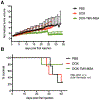Cancer Theranostic Applications of Albumin-Coated Tobacco Mosaic Virus Nanoparticles
- PMID: 30403330
- PMCID: PMC6485250
- DOI: 10.1021/acsami.8b12499
Cancer Theranostic Applications of Albumin-Coated Tobacco Mosaic Virus Nanoparticles
Abstract
Nanotechnology holds great promise in cancer drug delivery, and of particular interest are theranostic approaches in which drug delivery and imaging are integrated. In this work, we studied and developed the plant virus tobacco mosaic virus (TMV) as a platform nanotechnology for drug delivery and imaging. Specifically, a serum albumin (SA)-coated TMV formulation was produced. The SA coating fulfils two functions: SA provides a stealth coating for enhanced biocompatibility; it also acts as a targeting ligand enabling efficient tumor accumulation of SA-TMV versus TMV in mouse models of breast and prostate cancer. We demonstrate drug delivery of the chemotherapy doxorubicin (DOX); TMV-delivered DOX outperformed free DOX, resulting in significant delayed tumor growth and increased survival. Furthermore, we demonstrated the ability of SA-coated TMV loaded with chelated Gd(DOTA) for magnetic resonance imaging detection of tumors. In the future, we envision the application of such probes as theranostic, where first imaging is performed to assess whether the nanoparticles are effective at targeting a particular patient tumor. If targeting is confirmed, the therapeutic would be added and treatment can begin. The combination of imaging and therapy would allow to monitor disease progression and therefore inform about the effectiveness of the drug delivery approach.
Keywords: cancer nanotechnology; drug delivery; imaging; theranostics; tobacco mosaic virus.
Figures






Similar articles
-
Theranostic pH-sensitive nanoparticles for highly efficient targeted delivery of doxorubicin for breast tumor treatment.Int J Nanomedicine. 2018 Feb 27;13:1119-1137. doi: 10.2147/IJN.S147464. eCollection 2018. Int J Nanomedicine. 2018. PMID: 29520140 Free PMC article.
-
Using Peptide Aptamer Targeted Polymers as a Model Nanomedicine for Investigating Drug Distribution in Cancer Nanotheranostics.Mol Pharm. 2017 Oct 2;14(10):3539-3549. doi: 10.1021/acs.molpharmaceut.7b00560. Epub 2017 Sep 7. Mol Pharm. 2017. PMID: 28880092
-
Tobacco mosaic virus-based protein nanoparticles and nanorods for chemotherapy delivery targeting breast cancer.J Control Release. 2016 Jun 10;231:103-13. doi: 10.1016/j.jconrel.2016.02.045. Epub 2016 Mar 3. J Control Release. 2016. PMID: 26941034 Free PMC article.
-
Albumin Carriers for Cancer Theranostics: A Conventional Platform with New Promise.Adv Mater. 2016 Dec;28(47):10557-10566. doi: 10.1002/adma.201600038. Epub 2016 Apr 25. Adv Mater. 2016. PMID: 27111654 Review.
-
Nanoparticles as Theranostic Vehicles in Experimental and Clinical Applications-Focus on Prostate and Breast Cancer.Int J Mol Sci. 2017 May 20;18(5):1102. doi: 10.3390/ijms18051102. Int J Mol Sci. 2017. PMID: 28531102 Free PMC article. Review.
Cited by
-
Plant Virus Nanoparticles Combat Cancer.Vaccines (Basel). 2023 Jul 25;11(8):1278. doi: 10.3390/vaccines11081278. Vaccines (Basel). 2023. PMID: 37631846 Free PMC article. Review.
-
The pharmacology of plant virus nanoparticles.Virology. 2021 Apr;556:39-61. doi: 10.1016/j.virol.2021.01.012. Epub 2021 Jan 28. Virology. 2021. PMID: 33545555 Free PMC article. Review.
-
Recent Review on Biological Barriers and Host-Material Interfaces in Precision Drug Delivery: Advancement in Biomaterial Engineering for Better Treatment Therapies.Pharmaceutics. 2024 Aug 16;16(8):1076. doi: 10.3390/pharmaceutics16081076. Pharmaceutics. 2024. PMID: 39204421 Free PMC article. Review.
-
Virus-like nanoparticles as a theranostic platform for cancer.Front Bioeng Biotechnol. 2023 Jan 12;10:1106767. doi: 10.3389/fbioe.2022.1106767. eCollection 2022. Front Bioeng Biotechnol. 2023. PMID: 36714624 Free PMC article. Review.
-
An Overview of Polymeric Nanoparticles-Based Drug Delivery System in Cancer Treatment.Technol Cancer Res Treat. 2023 Jan-Dec;22:15330338231152083. doi: 10.1177/15330338231152083. Technol Cancer Res Treat. 2023. Retraction in: Technol Cancer Res Treat. 2024 Jan-Dec;23:15330338241276300. doi: 10.1177/15330338241276300. PMID: 36718541 Free PMC article. Retracted. Review.
References
-
- Lammers T; Kiessling F; Hennink WE; Storm G Drug targeting to tumors: principles, pitfalls and (pre-) clinical progress. J. Controlled Release 2012, 161, 175–187. - PubMed
-
- Vannucci L; Lai M; Chiuppesi F; Ceccherini-Nelli L; Pistello M Viral vectors: a look back and ahead on gene transfer technology. New Microbiol. 2013, 36, 1–22. - PubMed
-
- Bittner AM; Alonso JM; Górzny M; Wege C Nanoscale science and technology with plant viruses and bacteriophages. Subcell. Biochem 2013, 68, 667–702. - PubMed
MeSH terms
Substances
Grants and funding
LinkOut - more resources
Full Text Sources
Medical

